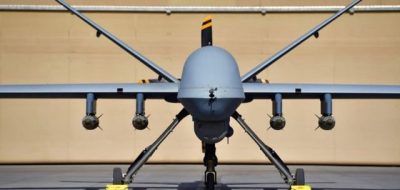Britain’s Flagship Drone Projects: UK Government Spending Watchdog Highlights “Significant Issues”

The Ministry of Defence’s two flagship drone projects – the ‘Protector’ programme to introduce the Certifiable Predator B drone into service with the Royal Air Force, and the Army’s Watchkeeper surveillance drone – continue to face ‘significant issues’ according to a government spending watchdog.
The latest annual report (published in July 2019) of the Infrastructure and Projects Authority (IPA), an agency of the Cabinet Office and the Treasury, has highlighted continuing problems, delays, and failures to meet delivery targets in each of the two programmes. According to the IPA the Protector programme “will deliver two years late and over original predicted cost” and the Watchkeeper programme, originally intended to be fully operational by 2010, is not expected to achieve “embodiment of final functionality” until the 2020/21 financial year.
Protector has been flagged with an Amber / Red programme rating by the IPA, which warns that that “successful delivery of the project is in doubt, with major risks or issues apparent in a number of key areas”. Although this is an improvement from the Red rating awarded last year, urgent action is still deemed necessary to address the problems or assess whether it is feasible to resolve them.

Source: Ministry of Defence via Drone Wars UK
The IPA study reveals that the Protector programme has been ‘rebaselined’, pushing the target date for Interim Operating Capability for the aircraft back back until November 2023, and for Full Operating Capability to October 2025. Delivery of Protector will now be two years late.
Civil servants have been forced to undertake a detailed financial review for the Protector programme, including adjustment of costs and renegotiation of contracts with suppliers. Although the review has now been concluded, the Review Note has yet to be approved and a new Mandate will be required for the project under the MoD’s programme management procedures.
During the 2018/19 financial year, there was a considerable underspend on the Protector programme, representing 18% of the budget for the year, which was caused by an increase in Joint Forces Command infrastructure costings and changes in foreign exchange rates. Despite this, the overall programme is predicted to come in at above the originally budgeted cost.
The woeful story of the Watchkeeper programme and the challenges it has faced has been well documented, but it seems that the difficulties, alas, have yet to be fully resolved. Watchkeeper has been awarded an ‘Amber’ project status rating by the IPA – the same as for the previous three years – meaning that “successful delivery appears feasible but significant issues already exist, requiring management attention”. However, the fact that the IPA study, published in July 2019, records the latest approved end date for the project as 3rd July 2017 speaks for itself.
The IPA report states that Watchkeeper finally achieved its Full Operating Capacity on 30th November 2018. However, a letter from Stephen Lovegrove, Permanent Secretary at the Ministry of Defence, to the Chair of the House of Commons Public Accounts Committee, Meg Hillier, in January 2018 indicated that Watchkeeper would not be granted release to service (RTS) clearance, also known as type certification, which is needed to show that it is safe and reliable enough to be used in routine training and operations.
“Despite this, the capability could be deployed operationally without formal Type Certification should the operational imperative warrant the necessary Operational Emergency Clearance,” Lovegrove wrote, somewhat alarmingly suggesting that the Army could be permitted to fly unsafe drones.
To date, no announcement has been made to indicate that Watchkeeper has been granted formal RTS certification, and until this happens the aircraft will only be able to fly under severe restrictions.
The IPA notes that remaining project deliverables for Watchkeeper are “ongoing” and that final functionality for the aircraft is expected in the 2020/21 financial year – ten years late. Only costs for Full Operating Capability are covered in the IPA assessment, which states that it does not include costs for “mid life obsolescence work planned for the next decade”, raising questions about MoD’s plans for the future of Watchkeeper.
The IPA report presents a somewhat chequered scorecard for the Protector and Watchkeeper programmes, suggesting that the Ministry of Defence is still in the learning phase for the procurement of its military drone programmes. Whether the learning will accelerate fast enough to ensure the successful delivery of Protector and future drone programmes remains to be seen.
*
Note to readers: please click the share buttons above or below. Forward this article to your email lists. Crosspost on your blog site, internet forums. etc.

